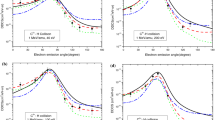Abstract
The majority of deexcited hadronic atoms (hX) (h=K −, \(\bar p\), ... and X=p, d, t) are accelerated up to energies of about 100 eV due to Coulomb transitions. The diffusion model of Stark transitions is developed. The resulting nuclear capture rate is higher than that in Bethe-Leon theory by a factor not less than five. Thus, only nonaccelerated atoms can survive. Therefore, the yield Y of Kα x rays is significantly less (by a factor of about ten) than that calculated in standard cascade models and is approximately equal to 0.2% and 1.0% for (K −p) atoms at hydrogen densities of N=2 × 1021 and 5 × 1020 atom/cm3, respectively. The scheme of a more accurate calculation of Y is also presented.
Similar content being viewed by others
References
C. J. Batty, Yad. Fiz. 13, 124 (1982) [Sov. J. Part. Nucl. 13, 71 (1982)].
L. I. Men’shikov, Muon Catal. Fusion 2, 173 (1988); Preprint No. IAE-4531/12 (Russian Research Centre Kurchatov Institute, Moscow, 1996).
W. Czaplinski, A. Gula, A. Kravtsov, et al., Muon Catal. Fusion 5/6, 59 (1990/91).
L. I. Ponomarev and E. A. Solov’ev, Preprint No. PSIPR-96-18 (Villigen, 1996); Pis’ma Zh. Éksp. Teor. Fiz. 68, 9 (1998) [JETP Lett. 68, 7 (1998)].
J. E. Crawford, M. Daum, R. Frosch, et al., Phys. Lett. B 213, 391 (1988); Phys. Rev. D 43, 46 (1991).
E. C. Aschenauer, K. Gabathuler, P. Hauser, et al., Phys. Rev. A 51, 1965 (1995).
T. B. Day, G. A. Snow, and J. Sucher, Phys. Rev. Lett. 3, 61 (1959).
M. Leon and H. A. Bethe, Phys. Rev. 127, 636 (1962).
J. L. Vermeulen, Nucl. Phys. B 12, 506 (1969).
V. S. Lisitsa and G. V. Sholin, Zh. Éksp. Teor. Fiz. 61, 912 (1971) [Sov. Phys. JETP 34, 484 (1971)].
Yu. N. Demkov, V. N. Ostrovsky, and E. A. Solovjev, Zh. Éksp. Teor. Fiz. 66, 125 (1974) [Sov. Phys. JETP 39, 57 (1974)].
V. A. Abramov, F. F. Baryshnikov, and V. S. Lisitsa, Zh. Éksp. Teor. Fiz. 74, 897 (1978) [Sov. Phys. JETP 47, 469 (1978)].
A. K. Kazansky and V. N. Ostrovsky, Phys. Rev. A 52, R 1811 (1995)
R. W. Pauli, Lectures in Atomic Mechanics (Nauka, Moscow, 1965).
L. I. Men’shikov and L. I. Ponomarev, Z. Phys. D 2, 1 (1986).
R. Baldini, S. Bianco, F. L. Fabbri, et al., DEAR Proposal. LNF-95/055 (IR) (Frascati, 1995).
T. P. Terada and R. S. Hayano, Phys. Rev. C 55, 73 (1997).
M. Iwasaki, R. S. Hayano, T. M. Ito, et al., Phys. Rev. Lett. 78, 3067 (1997).
E. M. Lifshitz and L. P. Pitaevskii, Physical Kinetics (Nauka, Moscow, 1987; Pergamon, Oxford, 1981).
G. Raifenrother and E. Klempt, Nucl. Phys. A 503, 885 (1989).
L. D. Landau and E. M. Lifshitz, The Classical Theory of Fields (Pergamon, Oxford, 1975; 6th ed., Nauka, Moscow, 1976).
Author information
Authors and Affiliations
Additional information
From Yadernaya Fizika, Vol. 63, No. 5, 2000, pp. 920–928.
Original English Text Copyright © 2000 by Men’shikov.
This article was submitted by the author in English.
Rights and permissions
About this article
Cite this article
Men’shikov, L.I. Cascade transitions in heavy hadronic hydrogen atoms. Phys. Atom. Nuclei 63, 850–858 (2000). https://doi.org/10.1134/1.855716
Received:
Accepted:
Issue Date:
DOI: https://doi.org/10.1134/1.855716



